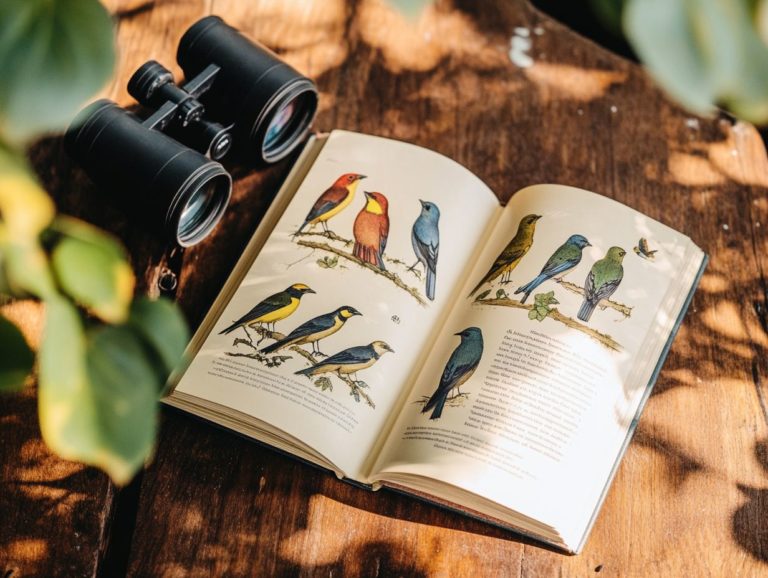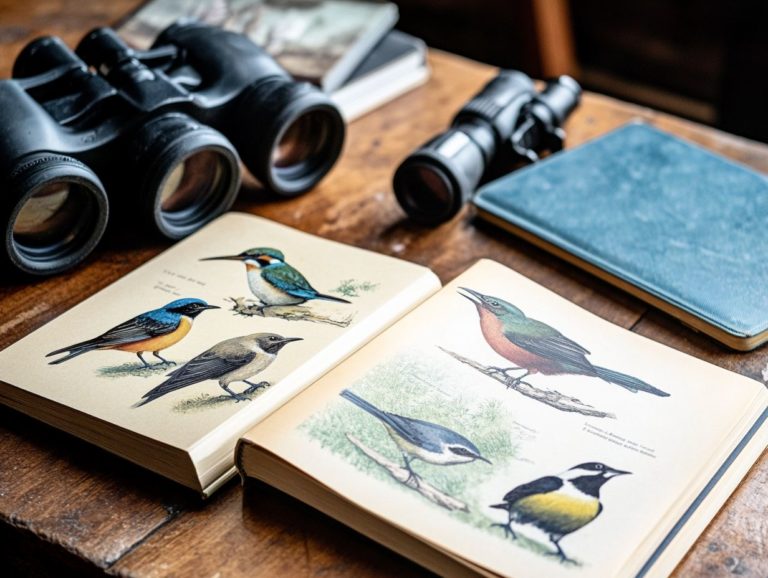The Ultimate Field Guide for Raptors in North America
Raptors are extraordinary birds that hunt during the day. They play an essential role in maintaining the delicate balance of ecosystems throughout North America, making bird identification an exciting pursuit for enthusiasts.
Picture the majestic bald eagle soaring gracefully over tranquil lakes, or envision the nimble kestrel expertly darting through sunlit fields. Consider using visual aids like major field guides for enhanced observation.
These birds showcase an astonishing diversity in behavior, size, and habitat, each contributing uniquely to their environment. This guide will equip you with insights into their distinctive characteristics, identification tips, and the various species accounts that inhabit North America, spanning from the Arctic to the Caribbean, featuring acclaimed authors such as Jerry Liguori and Richard Crossley.
You will learn about important conservation efforts dedicated to safeguarding these magnificent creatures. You will uncover the fascinating lives of raptors and appreciate their significance within our ecosystems, as noted in educational content by expert authors.
Contents
- Key Takeaways:
- 2. Characteristics and Behaviors of Raptors
- 3. Identifying Raptors in Flight
- 4. Raptors of the Eastern United States
- 5. Raptors of the Western United States
- 6. Raptors of Canada
- 7. Raptors of Mexico
- 8. Raptors of Central America
- 9. Raptors of the Caribbean
- 10. Raptors of Northern South America
- 11. Raptors of Southern South America
- 12. Raptors of the Arctic
- 13. Raptors of the Pacific Islands
- 14. Raptors of Hawaii
- 15. Conservation Efforts for Raptors in North America
- Frequently Asked Questions
- What is the Ultimate Field Guide for Raptors in North America?
- What is the Ultimate Field Guide for Raptors in North America?
- Who is this guide intended for?
- What information can I expect to find in this guide?
- Are there any special features in this guide?
- Is this guide suitable for beginners?
- Is this guide available in digital format?
Key Takeaways:
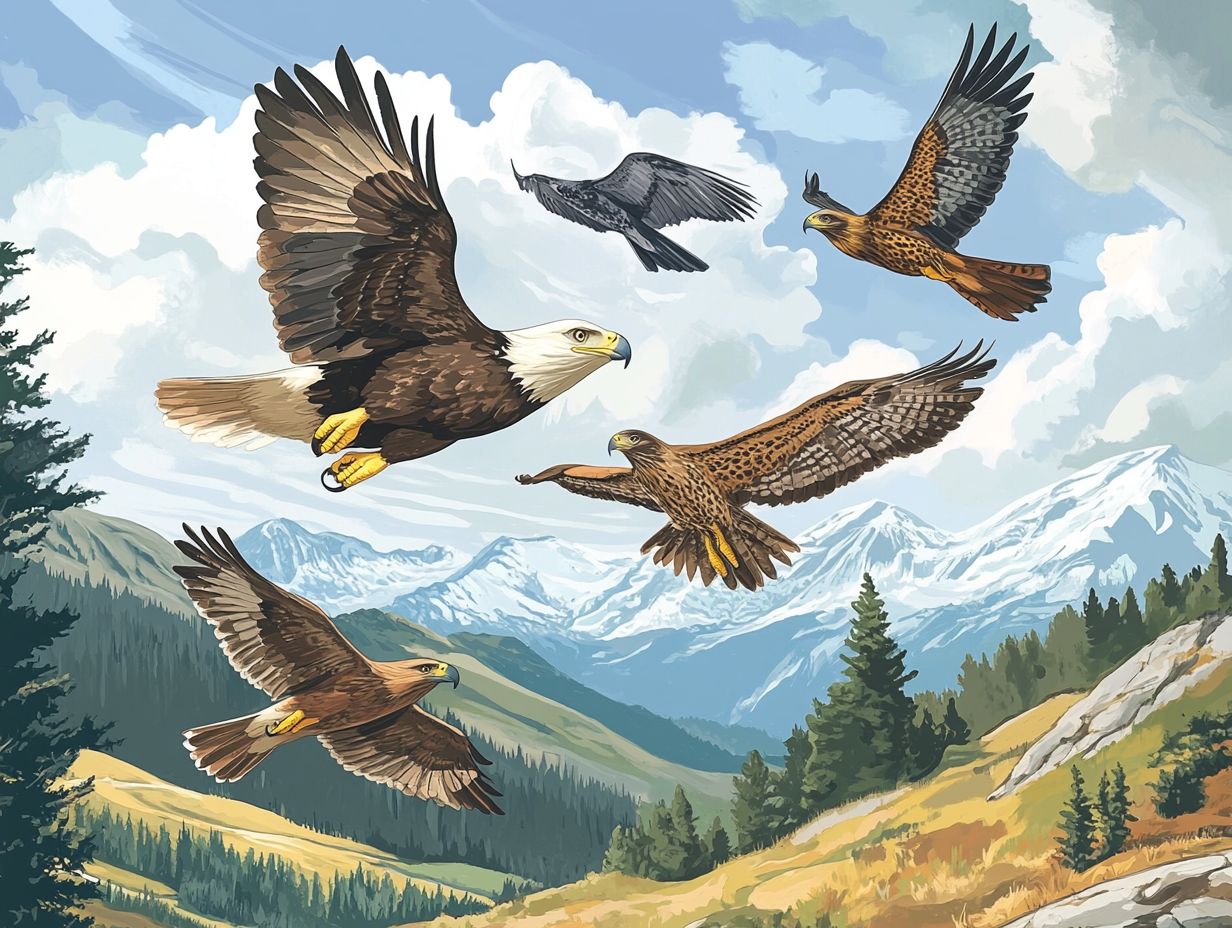
- Discover the diverse and fascinating world of raptors in North America, with over 100 species inhabiting the continent. Utilize a detailed reference like Sibley s Raptors for better understanding.
- Learn about the unique characteristics and behaviors of different raptor species and how to identify them in flight.
- Explore the various regions of North America and their specific raptor populations, including the Arctic, Pacific Islands, and even Hawaii, while using tools like photo comparisons for accurate identification.
2. Characteristics and Behaviors of Raptors
Raptors boast distinct characteristics and behaviors that truly set them apart from other bird species. This makes hawk identification an intriguing yet challenging pursuit for bird watchers like you. This is especially true for juvenile buteos, a type of hawk.
Among these remarkable birds, the Red-tailed Hawk commands attention with its broad wings and robust body. It often showcases a striking reddish-brown tail that comes alive in flight. Juvenile buteos can be a puzzle, displaying a range of plumage colors that complicate identification even further.
Pay close attention to their flight patterns, marked by soaring glides and sudden dives. These movements can offer essential clues as you observe them in action.
When hunting, these raptors rely on their exceptional eyesight and impressive aerial skills, often employing a stealthy mix of surprise by perching silently before swooping down on unsuspecting prey.
Their nesting habits involve building large stick nests in tall trees or cliffs. Many species embark on seasonal migrations, making them more prominent during specific times of the year.
For an avid bird watcher like yourself, patience is key. Look for them in open spaces or along roadsides while they hunt. Familiarizing yourself with their calls can also elevate your experience, transforming a simple outing into a thrilling quest to spot these magnificent birds in the wild, just as detailed in the raptor guide.
3. Identifying Raptors in Flight
Identifying raptors in flight can be both a rewarding and challenging experience, demanding keen observational skills and practical identification techniques along with a solid understanding of their unique flight patterns and characteristics.
To enhance your accuracy in recognizing various hawk species, it s beneficial to familiarize yourself with key features such as wing shape, tail length, and color variations, as outlined in major field guides.
Pay close attention to how these magnificent birds glide and maneuver, as each species boasts distinct habits that can tell you a lot.
Utilizing photo comparisons can also prove invaluable. Analyzing images of hawks from different angles allows you to catch subtle differences that might elude you in the moment. This is crucial for overcoming identification challenges.
Employing visual aids like field guides or smartphone apps can significantly boost your proficiency in identification, transforming your experience into something both enjoyable and educational while ensuring high photo quality.
4. Raptors of the Eastern United States
The Eastern United States is home to a variety of raptors. Iconic species like the Red-tailed Hawk and Cooper’s Hawk are uniquely adapted to their habitats.
The Eastern Screech Owl stands out with its remarkable camouflage. It blends in with tree bark, whether in busy cities or quiet rural areas, making it a favorite among bird lovers.
These skilled birds rely on keen eyesight and exceptional hearing to hunt mainly at twilight. They prey on small mammals and insects.
As seasons change, many raptors migrate long distances to seek warmer climates and find food. Others stay put, defending their territories all year long.
Raptors play a vital role in local ecosystems. They help control rodent populations and keep their habitats healthy.
5. Raptors of the Western United States
The Western United States features a variety of raptors. Among them are the majestic Golden Eagle and Osprey, each displaying unique hunting strategies.
These birds thrive in diverse habitats, from arid deserts to lush forests. You might see the Rough-legged Hawk gliding over open fields in winter or the Peregrine Falcon nesting on cliffs and skyscrapers.
Identifying these beautiful birds can be tricky because they often look alike. This can lead to identification challenges.
To enhance your birdwatching, get good binoculars and learn from available resources. Familiarize yourself with their calls and flight styles.
Joining guided birdwatching tours offers insights from experienced enthusiasts. This ensures your encounters with these captivating birds are memorable.
6. Raptors of Canada
Canada’s vast landscapes provide an ideal home for many raptor species. Among them are the iconic Bald Eagle, known for its size and grace, and the agile Turkey Vulture, which feeds on dead animals.
You can spot these majestic birds soaring over varied terrains, from the rugged coasts of British Columbia to the prairies of Alberta. Look for the fast Peregrine Falcon or the Great Horned Owl, distinguished by its tufts and haunting call.
Prime locations like the Bow Valley in Banff National Park and the Assiniboine Forest in Manitoba are must-visit spots. Here, you can watch these incredible birds in action.
Join conservation efforts to support these amazing birds. Their presence indicates a healthy ecosystem and helps maintain biodiversity that supports both plants and animals throughout Canada.
7. Raptors of Mexico
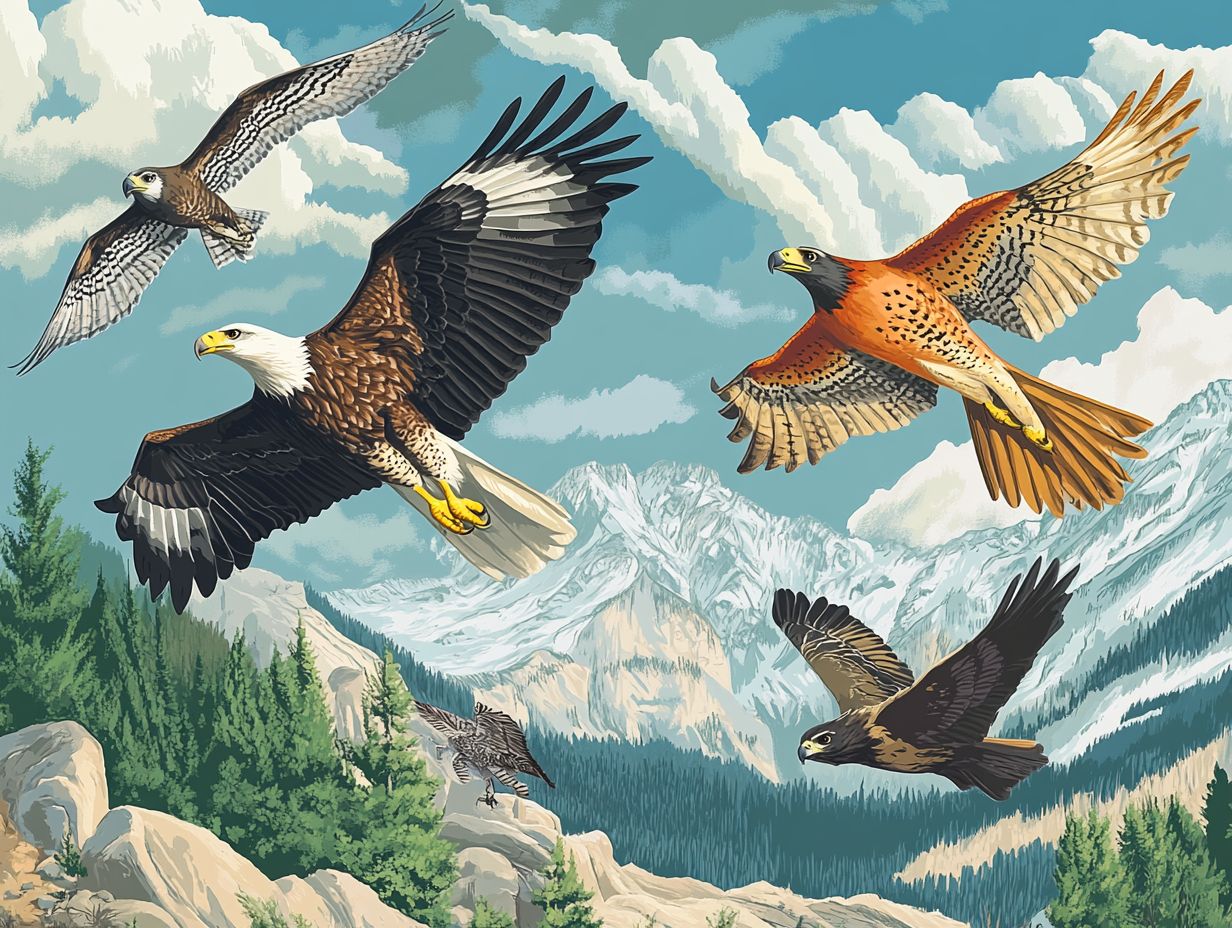
In Mexico, you will discover a captivating array of raptors, including the stunning Aplomado Falcon. This country offers a dream destination for both bird enthusiasts and raptor photography aficionados eager to capture the beauty of nature.
You ll find these incredible birds of prey in habitats ranging from arid deserts to lush rainforests and mountainous regions. Their remarkable adaptations allow them to thrive in unique environments, showcasing nature’s ingenuity. Raptors like the majestic Golden Eagle and the agile Peregrine Falcon are vital to ecological balance. They also carry deep significance in local cultures, often depicted in detailed reference materials by acclaimed authors.
Many communities hold these species in high regard, seeing them as powerful symbols of strength and freedom. As habitat loss and environmental changes increasingly threaten these magnificent birds, conservation efforts become crucial. It s essential to emphasize the importance of educational guides that can aid in this fight. Initiatives aimed at protecting their populations are vital to ensure that they continue to soar gracefully across the skies of Mexico.
8. Raptors of Central America
Central America boasts a captivating array of raptors, each playing a vital role in its ecosystem. This makes bird identification essential not just for enthusiasts, but also for effective conservation efforts.
Among these magnificent birds are ornate hawks, powerful eagles, and nimble falcons. They thrive in diverse habitats ranging from lush rainforests to expansive savannas. However, these remarkable raptors face numerous challenges, including habitat loss due to deforestation and climate change. The urgency for a detailed reference to help identify these species and their habitats cannot be overstated.
You can contribute significantly to raptor conservation by educating local communities about the importance of protecting these species. Use engaging formats that effectively inform and inspire action. By raising awareness through workshops, informative materials, and community engagement, you can motivate others to protect these extraordinary birds and their habitats for generations to come.
9. Raptors of the Caribbean
The Caribbean region showcases a diverse array of raptors, including the majestic Red-tailed Hawk and the Common Kestrel. Bird enthusiasts like you have exceptional opportunities for observation and study.
These birds of prey are vital for maintaining ecological balance in their habitats. They serve as both top hunters in their environments and indicators of environmental health, highlighting the necessity of proper bird reference materials. Their hunting patterns help control rodent populations, and their mere presence reflects the vitality of the ecosystems they inhabit.
However, habitat loss due to urbanization and agricultural development poses significant threats to these remarkable avian species. Such losses can disrupt the intricate ecological relationships in their habitats, potentially leading to broader consequences.
Therefore, concerted conservation efforts are essential not only to protect these raptors but also to preserve the rich ecosystems of the Caribbean. By taking action, you can help ensure that future generations appreciate the beauty and significance of these magnificent birds and understand the importance of bird identification techniques.
Join the fight for raptor conservation today!
10. Raptors of Northern South America
Northern South America boasts a remarkable diversity of raptors, including the versatile Common Kestrel, which thrives in various habitats throughout the region.
Get ready to be amazed by these magnificent birds! From the nimble American Sparrowhawk to the formidable Harpy Eagle, they display behaviors that highlight their adaptability to lush rainforests and arid terrains. For those passionate about birdwatching or conservation, having a reliable raptor guide at your fingertips is essential.
Such guides assist in accurately identifying different species and provide species accounts that offer valuable insights into their breeding patterns, feeding habits, and migratory routes. This knowledge is essential for anyone interested in identifying hawks.
By deepening your understanding of these raptors and their ecological roles, you can actively participate in their protection. Use detailed reference materials and focus on preserving their habitats, ensuring that these iconic birds continue to grace the skies of Northern South America for generations to come.
11. Raptors of Southern South America
Southern South America offers an impressive array of hawk species, presenting thrilling opportunities for you whether you’re a bird enthusiast or a dedicated researcher to witness these remarkable birds in action and learn more about hawk species.
The region’s diverse ecosystems, ranging from the lush green canopies of the Amazon Basin to the dry expanses of the Patagonian steppes, create unique habitats perfectly suited for various raptor species.
As you observe these hawks, their captivating behaviors will amaze you. Watch them employ a range of hunting techniques and intricate migratory patterns, all while adapting seamlessly to their ecological niches.
Increasing habitat loss and environmental changes pose significant threats to their populations, underscoring the urgent need for conservation efforts.
Educational guides serve as invaluable resources in this endeavor, enhancing your understanding and appreciation of these majestic creatures, particularly through visual aids and informative guide materials. They promote awareness and inspire meaningful conservation actions, fostering a deeper appreciation for biodiversity in Southern South America.
12. Raptors of the Arctic
The Arctic region poses unique challenges for raptor identification, thanks to its extreme conditions and seasonal shifts. Yet, it is home to a handful of remarkable species that are well worth your attention.
These birds of prey have honed incredible adaptations to survive in such inhospitable climates. They sport specialized plumage for insulation and possess keen eyesight that allows them to spot prey across vast, snow-covered landscapes.
When you explore this frigid environment, whether as a conservationist or a wildlife photographer, you aim to capture stunning images of these majestic raptors. You also want to raise awareness about the urgent challenges they face, like habitat loss and climate change.
Documenting their behaviors and movements through your lens plays a crucial role in understanding their ecology. It shines a spotlight on the urgent need for targeted conservation efforts, further emphasizing the importance of hawk watch programs that monitor and protect hawks.
13. Raptors of the Pacific Islands
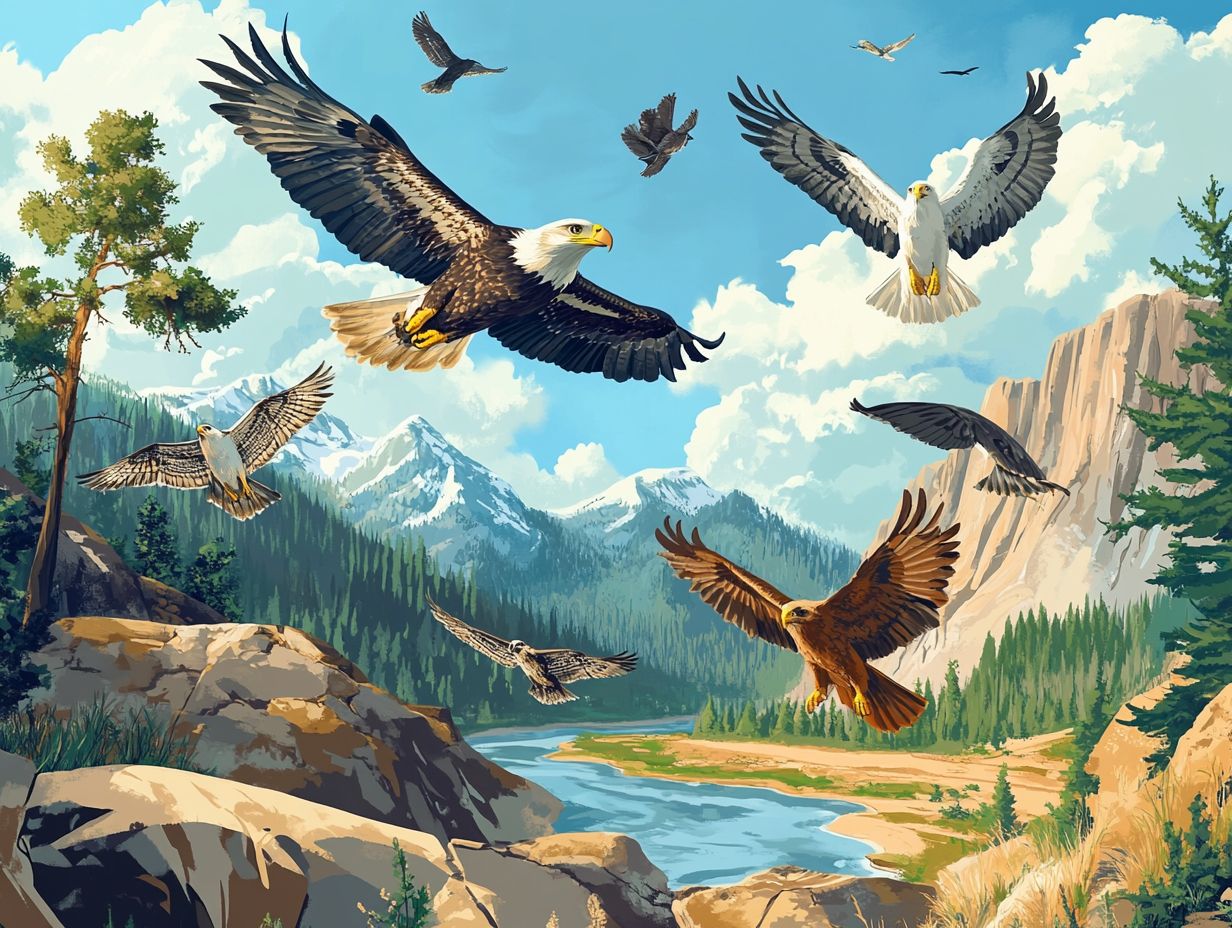
The Pacific Islands offer a unique collection of raptors, each one perfectly adapted to its isolated environment. This presents thrilling opportunities for raptor photography and observation.
Navigating the dense vegetation and rugged terrain to observe these magnificent birds can be quite a challenge. Their shy behavior and low population densities can make identification tricky, especially if you’re just starting out in birdwatching.
Protecting these raptors is crucial! Every effort counts in the fight against habitat loss, invasive predators, and climate change. Local organizations devote themselves to restoring habitats and educating communities about the importance of safeguarding these remarkable birds.
Through educational content, this commitment ensures that future generations will have the chance to appreciate the beauty and ecological significance of raptors in these stunning islands.
14. Raptors of Hawaii
Hawaii’s unique environment is a treasure trove for raptors that play a vital role in the ecosystem, offering bird watchers exceptional experiences and valuable educational insights.
Among these captivating birds, you ll discover the majestic Hawaiian ‘I’o, renowned for its striking appearance and remarkable hunting prowess, alongside the native Hawaiian Pueo, a nocturnal owl that has won the hearts of many enthusiasts. By looking into their behaviors and habitats, you can gain a deeper appreciation for these remarkable species.
It’s crucial to recognize that conservation efforts are vital. We must act now to protect these incredible birds, as habitat loss and introduced predators present significant challenges. Communities must engage in informative resources that promote awareness.
Raptor guides are invaluable for enriching your bird-watching adventures. They share fascinating insights about these magnificent creatures, helping you forge a connection with nature while promoting awareness and strategies for protecting the raptors you encounter, including Red-tailed Hawk and Golden Eagle.
15. Conservation Efforts for Raptors in North America
Conservation efforts for raptors in North America are becoming increasingly vital, addressing pressing challenges like habitat loss and pollution to ensure these magnificent birds thrive for generations to come. In this region, North American raptors like the Bald Eagle and Osprey are of particular focus.
You ll find that various strategies have emerged, including habitat restoration to replenish and protect areas essential for nesting and feeding. Wildlife organizations are actively implementing breeding programs that monitor raptor populations and educate the public on the importance of preserving these incredible species.
Community initiatives are crucial for fostering engagement and awareness. By organizing informative workshops and interactive outings, passionate educational guides offer valuable insights into raptor behaviors and their ecological significance, providing identification tips that inspire local residents to actively participate in conservation efforts.
Frequently Asked Questions
What is the Ultimate Field Guide for Raptors in North America?
The Ultimate Field Guide for Raptors in North America is a comprehensive book that provides information and illustrations on all species of raptors found in North America, making it an essential resource alongside top field guides for birding in national parks for bird identification.
What is the Ultimate Field Guide for Raptors in North America?
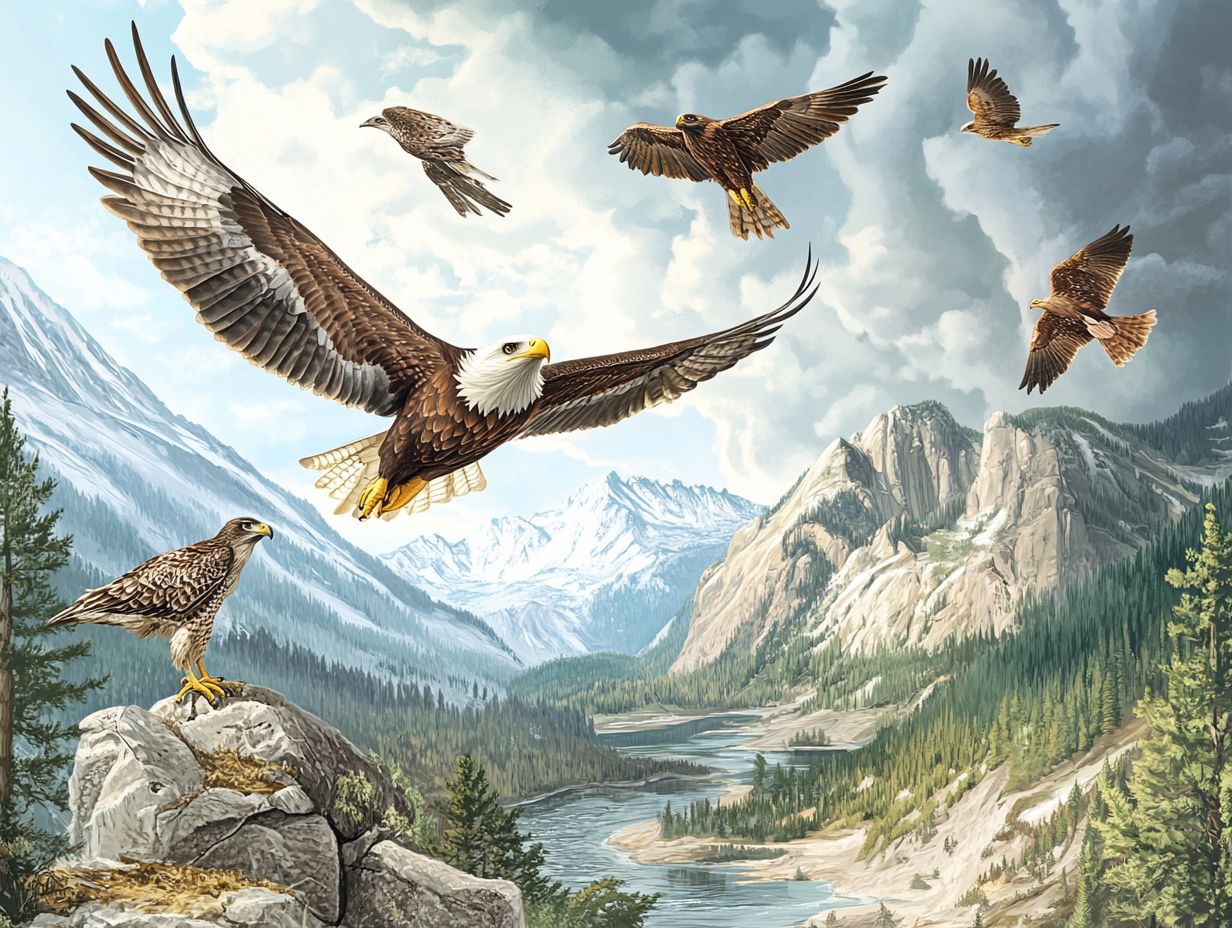
The Ultimate Field Guide for Raptors in North America is a comprehensive book that provides information and illustrations on all species of raptors, but for a broader perspective, consider checking out the top 10 field guides for North American birds as well.
Who is this guide intended for?
This guide is meant for bird enthusiasts, bird scientists, and anyone interested in learning about the different species of raptors in North America, especially those eager to explore the major field guides available.
What information can I expect to find in this guide?
This guide includes detailed descriptions, illustrations, and distribution maps of various raptor species. It also provides insights into behavior, habitat, and conservation status of each species, along with photo comparisons images for easy side-by-side comparison and visual identification strategies to help you recognize these magnificent birds.
Are there any special features in this guide?
Yes! This guide includes QR codes for each species that can be scanned with a smartphone to access more information and bird calls, enhancing its educational content.
Is this guide suitable for beginners?
You ll find this guide user-friendly, whether you’re a beginner or a seasoned birder! The illustrations and descriptions are easy to understand, and the QR codes provide additional information for those interested in learning more about bird watching practices.
Is this guide available in digital format?
Yes, the Ultimate Field Guide for Raptors in North America is available in both print and digital formats, making it easily accessible for anyone on-the-go and even providing a price comparison for various editions. Don’t miss out on the chance to explore the incredible world of raptors with insights from understanding bird behavior with field guides!



